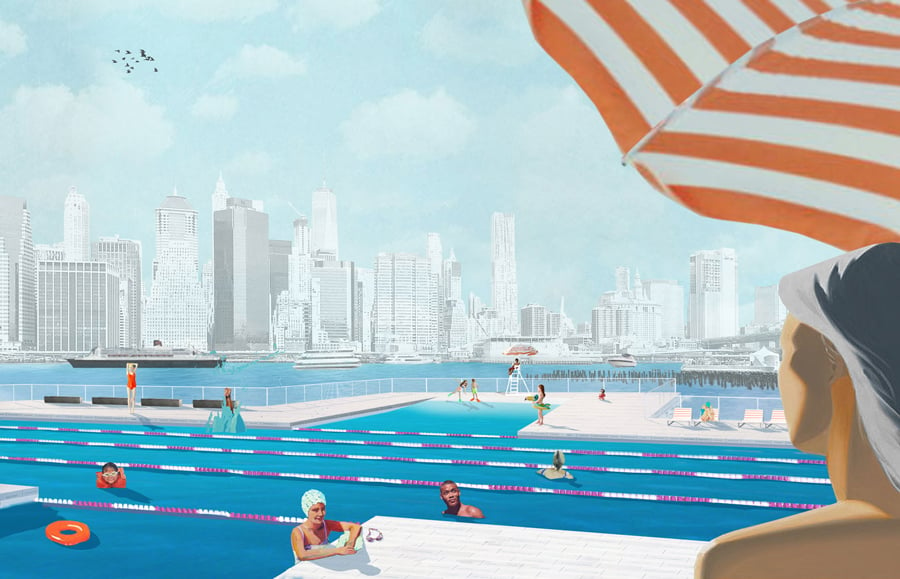
August 15, 2017
Plus Pool Asks New Yorkers to Show Their Support
The designers behind Plus Pool are looking to win people over. This new short film may just help.

New Yorkers often bemoan their city’s dearth of public space. They also complain about feeling unconnected to New York’s vast networks of waterways. Plus Pool, a free public swimming pool to be set in the East River, addresses both these urban shortcomings in a way that is innovative and idealistic, yet still fun. And with a recent corporate backing from Heineken’s Cities Project, the once improbable-sounding proposal seems increasingly buildable.
The idea behind Plus Pool is straightforward: a cross-shaped, Olympic-sized pool that filters river water and pumps sanitized water back out. “A giant BRITA filter is how we originally envisioned it,” says Archie Lee Coates IV, who hashed out the idea with friends and collaborators in 2011. Over a half-million dollars of research and testing later, the project has obtained the provisional go-ahead from engineers (including a few from Arup), and the next steps include raising public enthusiasm and garnering municipal support, goals the Plus Pool team—which includes cofounders Dong-Ping Wong, Oana Stanescu, and designer Jeff Franklin—hopes Heineken’s involvement can help advance.
“I immediately fell in love with it,” says Raul Esquer, brand manager of Heineken USA. Most of Heineken’s brand volume comes from big American cities, he explains, and so the Cities Project is a way to give back. The partnership with Plus Pool resulted in a polished short film (narrated by the actor Neil Patrick Harris) that recapitulates the pool’s origin story and prototyping while also highlighting “the sustainable benefit the pool brings in protecting water resources in the city.” It also emphasizes how elegantly simple the proposal actually is.
But efforts to advance its realization have proved anything but streamlined. How to push a promising project like this up to the top of the city’s seemingly endless municipal to-do list? For Coates, the experience of navigating this challenge has demonstrated “how hard it is to build a public space in New York because the city is so overwhelmed.” These days, much of the Plus Pool team’s time is occupied by meetings with city council members, neighborhood associations, and community boards.
The process, however, has helped the group formulate and refine Plus Pool’s overriding principles of accessibility and openness. The team members’ packed schedule of meetings with various residents and city officials shows they are committed to involving and engaging communities, says Coates, and they are constantly reshaping the plan to satisfy as many New Yorkers as possible. He insists that the latest version “is just one idea of many iterations.” What’s more, Plus Pool has been sponsoring a STEM school curriculum and free swim classes for disadvantaged youth from public housing across the city, in an effort to further connect all New Yorkers with the river pool endeavor.
Recently, Coates et al launched a drive to collect as many signatures as possible from people who feel compelled by the idea of swimming in the East River—something New Yorkers haven’t done since the 1930s. The move is intended to signal to skeptical public officials that widespread public support for Plus Pool exists beyond Kickstarter. (Since 2011, the cofounders have launched two successful Kickstarter campaigns.) Here is where Heineken’s Cities Project, which supports grassroots citymaking ventures, comes in. The new campaign is being hosted on the Cities Project website, and if signatures reach the 100,000 mark, the company says it will match the figure in dollars. “The way we support the project is to create a platform for people to get involved,” Esquer explains, “and we only want to get involved in a project that has the right traction.”
Plus Pool’s proposition is certainly captivating, and public enthusiasm for the scheme continues to grow. Coates tells of how he frequently receives calls from people asking where the pool is and which train runs closest to it. The team’s genuine attention to issues of social engagement and accessibility is particularly refreshing in a city where urban amenities are being eroded and where access to them is often restricted to those unable to pay for them. “At the end of the day,” Coates says, “it’s a pool that stands for New York City and all its residents.”
If you liked this article, you may also enjoy, “City Whisperers: Why Designers Are Essential to Demystifying Urban Developmentt.”





